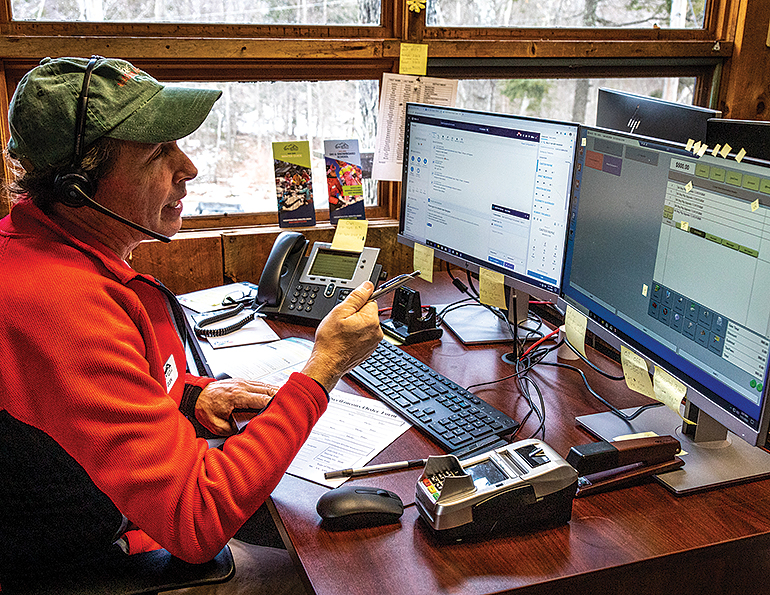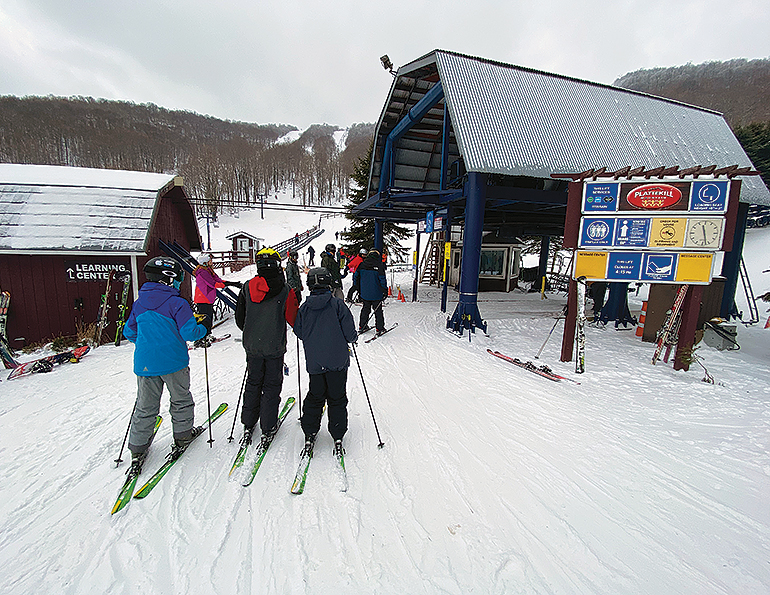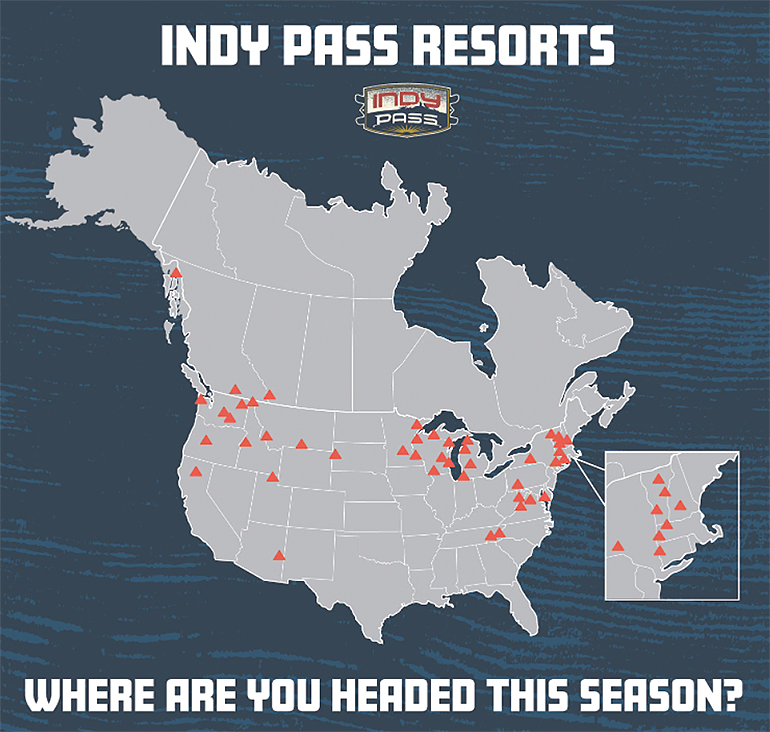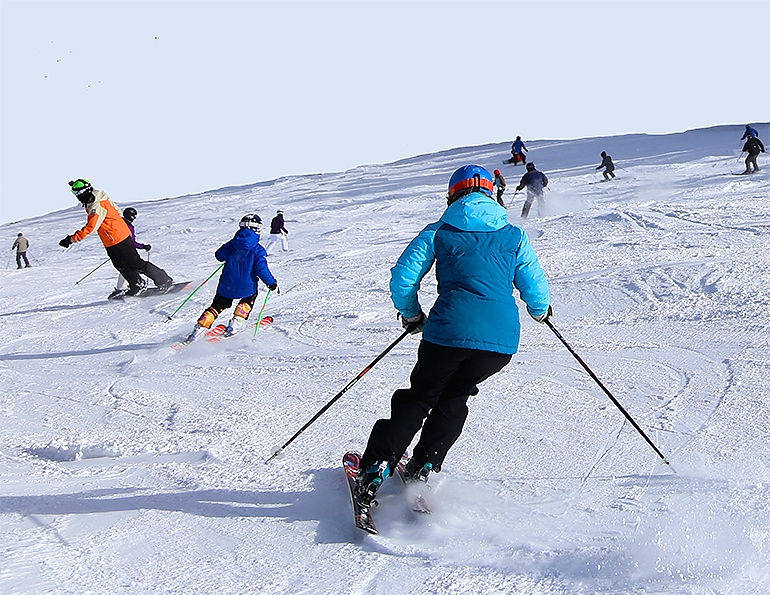In an ever-evolving quest to increase business, Wachusett Mountain outside Boston targeted “lapsed” customers as its top priority for the 2019-20 season. If you want to grow business, it’s preferable not to lose existing guests.
COO Carolyn Crowley Stimpson and marketing director Tom Meyers knew they had to develop a fresh approach, so they enlisted the help of North Carolina-based Six Degrees Analytics—a firm specializing in revenue-enhancement initiatives, among other things—for this special assignment.
Six Degrees introduced a new twist with an old tool: establishing a call center to supplement email and text efforts and provide a personal touch. The Six Degrees software isolated lapsed season-pass and 3-Peat card purchasers, set a protocol for rotating emails, texts, and phone calls, and then tracked the interactions.
Making it personal. Wachusett created a two-person call center and started dialing, even rifling through the White Pages when the initial contact info failed. The callers offered a $50 discount for season-pass renewals. It typically takes eight “touches” to drive a decision, but Wachusett often found success in half that amount of time—customers actually liked hearing from a company they respected. Plus, it wasn’t a robo-call.
 Wachusett‘s outreach team secures postive action twice as fast as other common means of outreach to lapsed season passholders and 3-Peat card holders.
Wachusett‘s outreach team secures postive action twice as fast as other common means of outreach to lapsed season passholders and 3-Peat card holders.
The effort sold more than 1,400 season passes and 3-Peat cards. Similar approaches are now being applied across the guest spectrum to reach what is perhaps best termed as the “fringe” customer: the lapsed, infrequent, on-the-fence, and often forgotten tribe who may well be the future of the sport, but too often are overlooked—and certainly underappreciated.
Lapsed Marketing
Wachusett is in the minority of resorts that are doing anything at all about re-engaging lapsed guests, much less employing sophisticated marketing efforts. That represents a missed opportunity. The NSAA Demographic Study has identified 8.5 million “lapsed” participants, almost equaling the total participants estimate of 10.3 million. A subsequent survey with resorts showed that only 37 percent of them had follow-up programs to address that huge group of lost customers. Most of those programs were aimed at lapsed passholders. Over-achieving Wachusett wants to target all its idlers, including “Learn to Turn” dropouts.
Fish marketing. Doug Fish is a street-smart, 40-year marketing veteran with solid ski-industry credentials and a big-picture vision. The founder and chairman of Portland, Ore.-based Fish Marketing + Strategy, Fish did his homework. He figured out that cost (tickets and gear) and time were the main barriers for lapsed and infrequent skiers. Then he compiled a compelling pitch for his “anti-Epic” Indy Pass for 2019-20, its first season.
The $199 pass, offering two days of skiing at each of 46 smallish resorts, is based entirely on targeting the “fringe”—the masses left behind in the mega-pass and overall season-pass mania that has swept the North American—and global—market.
 Weekend lift lines are often appreciably short at Plattekill Mountain in New York, one of the independent resorts on the new Indy Pass.
Weekend lift lines are often appreciably short at Plattekill Mountain in New York, one of the independent resorts on the new Indy Pass.
His five-year goal: 75 resorts and 100,000 passholders, which will fuel a $2 million marketing budget for activating the “fringe.” Resort marketing, he believes, typically targets the sophisticated high-end and the super-avid core, and is blind to the much larger group that wants a no-frills, authentic, affordable and uncrowded resort experience.
The Changing Landscape
The warning lights are flashing red, even in the midst of what is arguably the most successful marketing initiative in the sport’s history—the mega-pass phenomenon that has itself communicated a large-scale value message to the most passionate skiers, and helped bring sustainable profitability to dozens of resorts, which then pour capital into their own operations. While some mega-pass resorts scramble to deal with overcrowding, the overall participation model is out of balance and unhealthy, with near total reliance on the small core, while the disconnected, disjointed masses are seemingly left out in the cold.
Reliance on the core. The roughly 28 percent of participants who ski six days or more are delivering 70 percent of the skier visits, according to the 2017-18 NSAA Demographic Study, an even less balanced ratio than the obsessed upper tier in other sports like, say, golf. While the resort business rides these 2.5 million pass-holding uber-customers to fame and fortune (will it last forever?), a much larger group on the fringe, perhaps numbering as much as 14 million, didn’t get the invite.
For the first time with its 2017-18 survey, NSAA’s Demographic Survey asked skiers how many days they planned to ski. The “one-day” category totaled 2.5 million participants, and the “two-to-three day” group comprised 3 million. That represented 55 percent of the year’s participants, but just 17 percent of the skier visits. There was also a large block of “tweener” participants who were missing out on the deals, buying neither a season pass nor multi-day ticket. They often face ticket-window sticker shock, with an average adult weekend ticket at $131—and several large resorts are fetching more than $200.
Fringe Benefits
If even a small percentage of this broadly defined “fringe” group, comprised of the lapsed skiers plus the three-days-or-less skiers, was motivated to ski just one more day each season, the resulting skier visit increase could dwarf the mega-pass upside.
The dichotomy of mega-pass glory vs. fringe inertia has helped expose this split in attention, and some pundits have chosen to point fingers at the companies driving the former. Make no mistake, though—this is not the fault of the game-changing mega-pass or any of the smaller resort value passes. In fact, those existing best-customer relationships can provide an important part of the overall marketing solution, since many of them include discount ticket offers for a buddy who tags along with the passholder.
Newbies are typically beckoned by a passionate, knowledgeable skier to first sample and then commit to the sport. Buddy tickets encourage that process. With Ikon/Epic combined pass sales marching toward the two million mark, plus all the value passes at smaller areas, there are now abundant ambassadors for the sport, toting tens of millions of tag-along opportunities to entice newcomers or occasional skiers.
And it’s happening. This season, Eldora, a top performer in the Ikon world, had redeemed 5,000 Friends & Family passes by mid-December, a dramatic spike over the previous season. At Arapahoe Basin, which opted out of Epic and joined Ikon on a restricted five- or-seven-day usage basis, the resort did not collect data on Epic Pass tag-alongs. Now the area is offering Ikon buddies a greater discount than the standard 25 percent, and you can bet the area will be taking names.
So, the stage is set. It is up to resorts to collect customer data on these fringe friends, and follow up with a “comeback offer.” Better yet, can resorts dream of identifying this guest on arrival, and if it’s a newbie, direct them into a learning program, or at least give them a DIY tool kit?
Generational change? NSAA president Kelly Pawlak points to a potentially deeper benefit. “I’m hoping this [mega-pass and overall pass boom] will institute a generational habit like that of the Baby Boomers,” she says. If that happens with the 75-million Millennials and their children, the results could be remarkable.
Why The Time Is Right
A promising, albeit nascent, approach to studying and increasing participation is upon us, just in time. Under Pawlak’s leadership, NSAA has begun shifting away from a 20-year emphasis on “never-evers” and has broadened its scope. It went on the record with an ambitious goal: establishing annual skier visits of 60 million as the three-year average by 2025-26. That level has been achieved (or nearly so) just four times in the past three decades.
Pawlak jumped into the growth fray soon after accepting the job. She quickly learned there is no one-size-fits-all solution, and that addressing the various issues is “a marathon, not a sprint.”
Learn-to-ski efforts remain essential, particularly with youth who, hopefully, become customers for life. With the passing of the Learn to Ski and Snowboard Month initiative, other initiatives are trying to fill the void, including the robust Share Winter program, which is primarily privately funded but has scored significant contributions from NSAA and others. NSAA’s slow-to-launch Discover Snow program is another piece of the puzzle.
Now, the disparate fringe, the next low-hanging fruit on the tree after avid passholders (“never-evers” aren’t yet on the tree), begs for attention. NSAA’s recently established 18-member Growth Committee has created six sub-groups aiming at broad participation challenges, including “Energizing the Core,” which aims to inspire these participants to “ski one more day.” As it matures, that effort will hopefully focus not on getting the avid passholder to ski a 20th day (limited upside there), but to induce the less committed to ski a third or fourth day and—more significantly—return for more the next season.
To learn more about lapsed skiers, Pawlak commissioned a quick research study using member resorts to reach out to the lapsed group on social media and email; this was overseen by MRM Insights. Besides the lapsed participants’ usual reasons of time and cost, the MRM study also turned up “safety” concerns as a major factor: People feared an injury that might sideline them from work, even for a short time. So NSAA wants to address that, too.
To address the bigger picture, longtime NSAA research partner RRC Associates, which handles the annual Kottke and Demographic studies, will combine the two in one report this season. That should provide a broader and clearer picture of the overall marketplace.
The Vail Factor
Other developments are creating a perfect storm for growing the market. A dozen years ago, when Rob Katz arrived as CEO of Vail Resorts and began to implement his vision, the company included just five destination areas—and growing overall ski participation was not a priority.
With the purchase of three Midwestern resorts between 2012 and 2016, and the more recent Peak Resorts acquisition, that seems to have changed. And this season, Vail Resorts launched Epic for Everyone, to welcome the less committed “fringe” with day-ticket discounts. We now see how smart ski industry leaders pivot in the robust but still somewhat narrowly focused new world they created.
Peak’s areas feed the voracious Epic Pass with on-the-snow outreach into the homes of destination skiers in the Midwest, Mid-Atlantic, and Northeast. But the acquisition also entails a strong commitment to rolling up the sleeves on the gritty front lines of skier development. Katz and his wife, Elana Amsterdam, recently committed to donating $10 million over five years to skier development programs for underserved youth in metro areas near the Peak acquisitions, as well as cities near other Vail-owned properties.
Will Alterra follow suit? Look for Alterra to perhaps tread a similar path, continuing its quest to accomplish in an extraordinarily compressed timeframe—and in a way that leaves its own independent stamp—what Vail Resorts has accomplished in the last 12-plus years. Alterra executives like David Perry are quite cognizant of all these issues.
As far as an “Ikon for Everyone” for the 2020-21 season, Perry will only say that Alterra will “continue to evolve” its lift products—a more complex undertaking since about 30 of the resorts aligned with the Ikon Pass aren’t owned by the company. On the other hand, if Alterra sought to reach deeper into the day-area incubator markets around large metro areas, it could wet its toes with additional partnerships or some sort of affiliation to the Ikon Pass, rather than through resort ownership.
At the end of the day, it’s hard to see how either of the “Big Two” will be able to meet long-term investor and shareholder growth expectations if the market doesn’t grow. That’s a good thing for everybody.
What’s Working Now
Back at Wachusett, which regularly attracts around 400,000 annual visits to its slopes, Stimpson and Meyers know their current efforts are just part of an ever-evolving commitment to create “customer lifetime value.” Each day brings new insights, like changing the orientation of their lift ticket card from vertical to horizontal; the latter looks more transactional, like a credit card.
The lift-ticket window remains a challenge. When there are long lines on peak days, getting the customer data for a newcomer can extend the transaction from 30 seconds to five minutes. In lieu of that, the resort showers guests with signage reminding them they can use the WTP number on their card to buy more tickets online, at a big savings—thereby adding their contact info to the resort’s database.
The bigger goal, in cases from tag-along “friends and family” customers to newbies, is to compress that window data collection from five minutes to 60-90 seconds.
It’s a movement. Other resorts can be quick studies. The Wachusett outbound call center was smartly featured in seminars at this year’s NSAA winter confabs at Squaw Valley and Killington. One audience member at Squaw was Chris MacInnes, president of Crystal Mountain in Michigan. Crystal has an eight-person lodging reservations call center that has enjoyed huge success with follow-ups to lapsed or on-the-fence lodging guests and prospects. Now, she wants to expand the effort to include lapsed season-pass and even multi-day ticket holders, too.
 The eight-person lodging call center at Crystal Mountain, Mich., enjoys success in calling lapsed or on-the-fence lodging guests.
The eight-person lodging call center at Crystal Mountain, Mich., enjoys success in calling lapsed or on-the-fence lodging guests.
For Pawlak’s part, when the NSAA president was the GM at Mount Snow, she deployed a simple recruitment strategy for attracting infrequents: promote a ridiculously cheap lift ticket offer one weekday each month (like a $12 Founder’s Day ticket in December), attract thousands to the resort, collect all their info, and then follow up with offers.
Fishing for the Future
As for Fish’s infant Indy Pass, in its inaugural season it attracted resorts that are known and loved locally, but perhaps not nationally or even regionally. Though there were low redemptions at some resorts, not surprising in a maiden effort, Fish believes he will retain virtually all of the resorts for the sophomore season. (He expects the redemption rate to be $40 to $50 per use.) Fish plans to add corporate sponsors (craft beer loves Indy customers) and increase the program to 60 resort partners for next season. These will likely include more high-profile properties and, just as importantly, create critical geographic clusters of drive-to areas that will be practical to access for his value-seeking customers.

Ideally, the Indy Pass strikes pay dirt around cities where there are at least a few day-ski-area options, with easily doable overnight trips to larger, more weekend- and destination-oriented resorts. This triggers a snowball effect, where more resorts beget more passholders, which beget more resorts, and also can create spinoffs and new iterations.
As for outreach, Fish can’t yet offer anything revelatory: The Indy Pass relies heavily on Facebook advertising. Even so, he believes strongly enough in the upside to step away from the successful, 20-person agency he founded and ran for 17 years to take the Indy Pass on as his primary focus and to treat it like a startup, with a long-term ROI. He essentially works for free on the hope of a potential payout somewhere down the line, with the sublime perk of getting to visit and ski with his clients at small, soulful resorts around the country.
Meanwhile, the collaboration and idea-sharing that could be engendered among these far-flung (and not overly resourced) resorts could be significant; think of the Mountain Collective.
Whether the Indy Pass is ultimately successful or not in five years doesn’t diminish the message today. Savvy resorts long ago segmented their customer bases into families, high-rollers, DINKs, singles, etc. How about another segment for the disparate “fringe”?
Andy Bigford is the former editor-in-chief and publisher of SKI. He edited and collaborated on the writing for Chris Diamond’s two books, Ski Inc., and, most recently, Ski Inc. 2020. They plan to co-author another Ski Inc. sequel, tentatively planned for release in October 2022.






